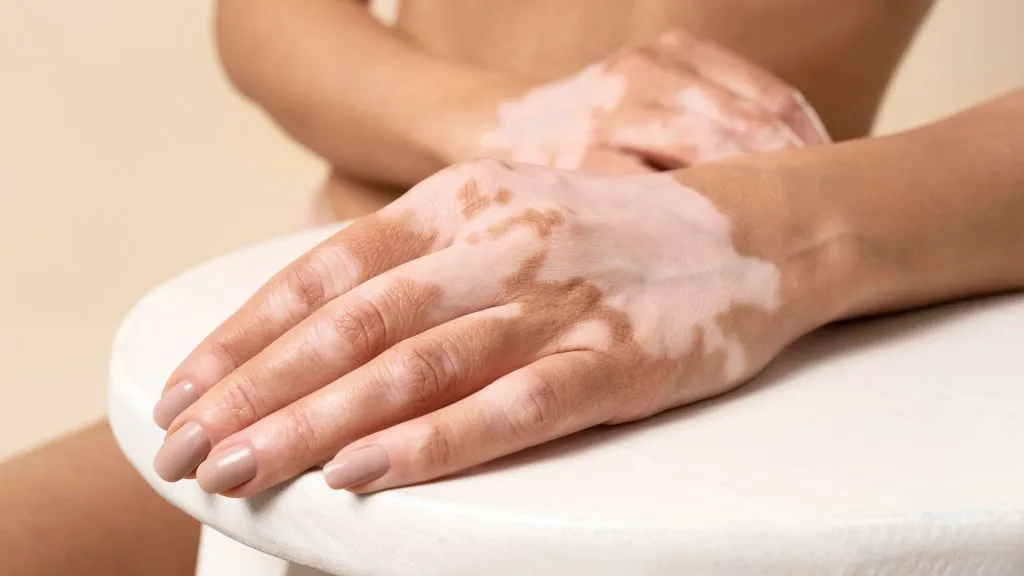What is Vitiligo? A Complete Beginner’s Guide
Imagine looking in the mirror one morning and noticing a small white patch on your skin that wasn’t there before. You may feel confused or even worried but you’re not alone. Millions of people worldwide experience the same condition. It’s called Vitiligo, and understanding it is the first step toward confidence, care, and clarity.
What is Vitiligo?
Understanding what is Vitiligo helps demystify this skin condition.

Many people wonder, what is Vitiligo? It is crucial to know that it is a condition affecting your skin pigmentation.
When asking what is Vitiligo, you should also consider its emotional impact.
For those seeking answers on what is Vitiligo, it is essential to understand the various causes.
This leads us to the question, what is Vitiligo and how does it affect the body?
To answer what is Vitiligo, one must look at it as a skin condition with various implications.
In summary, what is Vitiligo encompasses skin changes that need awareness.
Vitiligo is a long-term skin condition where certain areas of the skin lose their natural pigment (melanin), resulting in white or light-colored patches. These patches can appear anywhere on the face, hands, elbows, knees, or even inside the mouth.
It’s not contagious, not painful, and not dangerous. But it can affect how a person feels about their appearance, which is why awareness and early understanding matter so much.
What Causes Vitiligo?
The exact cause of vitiligo isn’t fully understood, but doctors and researchers agree that it’s mostly linked to an autoimmune disorder. Here’s how it works:
Your immune system is designed to protect your body, but in people with vitiligo, it mistakenly attacks melanocytes the cells responsible for producing skin pigment. When these cells are damaged or destroyed, the skin loses its color in certain areas.
Other possible causes include:
- Genetics: A family history of vitiligo or autoimmune diseases can increase the chances of developing it.
- Sunburn or Skin Trauma: Severe sunburn or cuts may trigger new patches.
- Chemical Exposure: Certain industrial chemicals may affect melanocytes.
- Stress: Emotional or physical stress can sometimes worsen the condition.
- Associated Autoimmune Disorders: People with thyroid, diabetes, or lupus are slightly more at risk.
Types of Vitiligo
Knowing what is Vitiligo can help individuals find the right support.
Each type of vitiligo shares a common question: what is Vitiligo and how does it manifest?
Vitiligo appears in different patterns and forms. Dermatologists classify it into several main types:
| Type | Description |
|---|---|
| Non-Segmental Vitiligo | The most common type. Symmetrical patches appear on both sides of the body, often spreading over time. |
| Segmental Vitiligo | Affects only one side or one area of the body. Usually appears in childhood and spreads for a limited time. |
| Mixed Vitiligo | Combination of both segmental and non-segmental patterns. |
| Universal Vitiligo | In rare cases, depigmentation covers most of the body. |
Ultimately, understanding what is Vitiligo helps in managing personal expectations.
Symptoms of Vitiligo
The first sign of vitiligo is usually a small white or light patch on the skin. Over time, this may spread to other areas. Common symptoms include:
- White patches on the skin with clear borders
- Premature graying of scalp hair, eyebrows, or eyelashes
- Color loss inside the mouth or nose
- Mild itching before new patches form (in some cases)
Vitiligo doesn’t cause pain or physical discomfor but emotionally, it can sometimes be challenging.
As we explore what is Vitiligo, we uncover the importance of early diagnosis.
How is Vitiligo Diagnosed?
If you notice unusual patches on your skin, the best step is to consult a dermatologist. Diagnosis usually involves:
- Visual Examination: The doctor examines the skin closely.
- Wood’s Lamp Test: A special ultraviolet light makes depigmented areas visible.
- Blood Tests: To check for autoimmune conditions like thyroid disorders.
- Skin Biopsy (Rare): In unclear cases, a small skin sample may be analyzed.
Early diagnosis helps manage symptoms more effectively and slow progression.
Treatment Options for Vitiligo
While there’s no complete Vitiligo cure yet, several treatments help restore color and stop further pigment loss. The right option depends on your age, health, and patch size.
1. Topical Creams
For individuals seeking clarity, what is Vitiligo can offer insight into their condition.
Many treatments answer the question, what is Vitiligo and how can it be treated effectively?
Doctors often start with corticosteroid or calcineurin inhibitor creams to reduce inflammation and encourage pigment return.
2. Phototherapy (Light Therapy)
Controlled exposure to ultraviolet light helps activate melanocytes and promote repigmentation. Narrowband UVB therapy is especially effective.
3. Surgical Treatments
For stable vitiligo, skin grafting or melanocyte transplants may be used to restore pigment.
4. Camouflage & Cosmetics
Special makeup or self-tanning products can cover white patches and even out skin tone temporarily.
Additionally, knowing what is Vitiligo can help patients choose suitable cosmetic options.
5. Natural Remedies Vitiligo & Oils
Embracing what is Vitiligo may lead to exploring natural remedies.
Some people prefer herbal approaches like Psoralea Corylifolia (Babchi) oil or antioxidant-rich oils to support skin health naturally. While natural oils don’t “cure” vitiligo, they help nourish and soothe affected areas when used safely under guidance.
Skin Care Tips for People with Vitiligo
Because depigmented skin lacks melanin, it’s more sensitive to Vitiligo sunlight. Here are essential care tips:
- Always use broad-spectrum sunscreen (SPF 30+)
- Wear protective clothing and wide-brimmed hats
- Avoid harsh soaps or chemicals on your skin
- Keep skin moisturized daily
- Eat foods rich in antioxidants (berries, green tea, dark chocolate)
Emotional and Social Well-Being
Vitiligo doesn’t define your worth or beauty. Many people, including celebrities like Winnie Harlow, have turned their condition into a source of strength and confidence.
If you ever feel isolated, join vitiligo support groups both online and local to connect with people who understand your journey. Talking about your experience can help reduce emotional stress and build self-esteem.
New Developments in Vitiligo Research
The medical world is advancing rapidly. New treatments are being tested, such as:
Thus, understanding what is Vitiligo opens doors to emotional healing.
- JAK inhibitors: A new class of medication showing promising results in re-pigmentation.
- Stem cell therapy: Researchers are exploring how stem cells can regenerate melanocytes.
- Natural and plant-based solutions: Combining herbal treatments with modern therapies for holistic care.
These breakthroughs bring hope for better vitiligo management in the near future.
Living Confidently with Vitiligo
Ultimately, the question remains: what is Vitiligo and how do we move forward?
Vitiligo may change your skin’s appearance but not your identity, dreams, or value. Accepting and caring for your skin is the most empowering thing you can do.
“Your skin tells your story wear it with pride, not fear.”
With the right knowledge, treatment, and self-love, you can live beautifully and confidently, no matter your skin tone.
Final Thoughts
Understanding what is vitiligo empowers you to make informed decisions about your skin and well-being. From medical treatments to emotional healing, every step counts toward self-acceptance and care.
Vitiligo is not the end of beauty it’s a new beginning of embracing uniqueness and strength.
In conclusion, what is Vitiligo is a vital part of understanding skin health.








Add comment